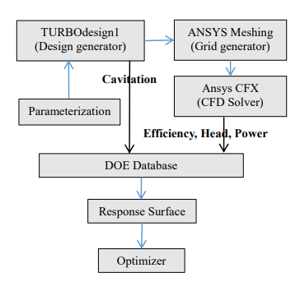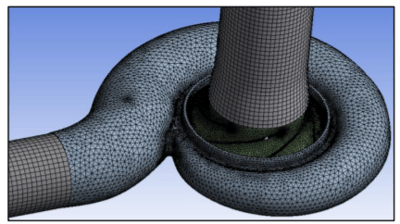Franklin Electric is a global leader in the manufacturing and distribution of products and systems focused on the movement and management of water and fuel. They offer pumps, motors, drives, and controls for use in a wide variety of residential, commercial, agricultural, industrial, and municipal applications.
Franklin Electric aimed to improve the efficiency and cavitation performance of their high specific speed pump range pump stage. The key was to come up with a design quickly. Gabriel Davila, Development Engineer at Franklin Electric, has been using TURBOdesign Suite and the 3D Inverse Design technology for a number of years and recently explored the coupling between TURBOdesign1 and Ansys CFX via Workbench integration in order to tackle such complex multi-objective and multipoint optimizations.
Optimize your design process by integrating TURBOdesign1's 3D Inverse Design method with Ansys Workbench:
Centrifugal pumps have a wide range of applications in various industries. They are often used in power plants, chemical
processing and municipal water supply system. Centrifugal pumps constitute a dominant portion of the world production of pumps, they also consume about 10% of electrical power worldwide. Good performance and high reliability of the centrifugal pumps have been actively pursued by the pump manufacturers. The hydraulic design has adopted sophisticated tools such as CFD simulations due to the late developments of the computing capabilities and advances in numerical methods.
Yet, a fast design process that can meet many contrasting objectives remains a challenge. In many cases, the impeller has to achieve both high efficiency and good cavitation performance. Structural requirements and manufacturing limits also put constraints on the hydraulic designs. An efficient design system is desired to be able to explore a large design space while providing information on the trade-offs between multiple design objectives.
In this work, a multi-objective optimization strategy for a high specific speed centrifugal volute pump design is proposed.
The optimization framework uses a 3D inverse design tool TURBOdesign1 to generate the impeller geometries. TURBOdesign1 uses a 3D inviscid flow solver and can solve both compressible and incompressible flow. It not only generates the blade geometry but also provides an accurate 3D inviscid flow field solution, which compares well with CFD results in terms of surface static pressure. It usually computes the blade shape and the resulting flow field in a few seconds on a single core and hence can be coupled with an optimizer to explore the design space for multi-objective requirements, resulting in significant reductions in computational time versus optimization based on conventional design method coupled with 3D CFD.

Fig. 1. Flowchart of the optimization work.
Another advantage of the inverse design tool lies in the way it parameterizes the blade geometry. For a 3D turbomachinery blade a large number of parameters are usually required to describe the geometry, which results in a high demand on the computational resource. TURBOdesign1 generates the blade geometry by specifying the loading parameters and enables one to represent a large design space with a few design parameters. Furthermore, the inverse design based optimization will automatically ensure that each geometry generated satisfies the required Euler head and hence it is easy to create an accurate surrogate model based on a relatively small design matrix created by Design of Experiments method. The surrogate model can then be used by a multi-objective genetic algorithm to trade off different objectives at multiple operating points in a few minutes.
The pump stage used for this study is a high specific speed (non-dimensional value 0.99; 407 based on rpm, m and m3/min; 2711 based on rpm, US gpm and ft) centrifugal water pump with a downstream volute. It is an existing pump designed and numerically simulated and optimized by Franklin Electric Co., Inc.. After verifying the performance by the laboratory test, Franklin Electric Co. Inc. manufactured and commercialized the optimized design. The discussion will start by outlining the design parameters and the methodology for the optimization of the pump impeller, with the target of improving its efficiency and cavitation performance.
The first approach we used is based on Design of Experiments method and the computation of efficiency by 3D RANS code, while the criterion for cavitation is taken as the minimum static pressure on blade suction surface predicted by TURBOdesign1. Both the meridional profile and the blade shape are parameterized. A Pareto-optimization is then carried out on the response surface to maximize the efficiency, and to minimize the cavitation.
The new optimized stage (with the downstream volute retooled but kept mainly unchanged) is manufactured and its performance tested. In order to further investigate possible speedup of the optimization process, an additional optimization has been carried out based on TURBOdesign1 outputs only for both efficiency and cavitation.
In this case, no CFD simulations are needed. The results show that by carefully choosing the objectives and the constraints, it is possible to produce designs that have similar performance to the optimized design from CFD data, hence saving considerably more on the computational time. Furthermore, in order to investigate how the inverse design based optimization compares to the one based on the conventional design (where the blade geometry is parameterized without aerodynamic inputs) we show the results of an equivalent optimization for the same pump impeller by using a conventional design (ANSYS BladeModeler) based parameterization.
 Fig. 2. Computational domain and mesh detail.
Fig. 2. Computational domain and mesh detail.
To discover the methodology used and the results, we invite you to download the paper here.
To learn more about the challenges faced by Franklin Electric to design high performance pumps, the design and optimization process coupling ADT's TURBOdesign Suite and ANSYS's Workbench and CFX and the unique advantages of performing multi-objective optimization based on 3D Inverse Design, you can read our case study with Franklin Electric:
Mehrdad Zangeneh
Mehrdad Zangeneh is Founder and Managing Director of Advanced Design Technology and professor of Thermofluids at University College London.
View All Articles








Share This Post